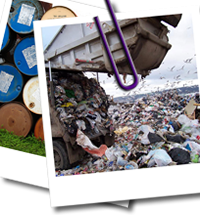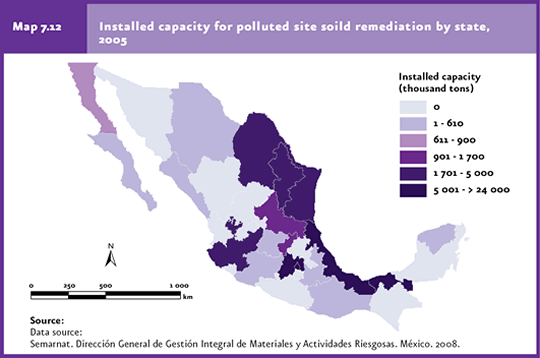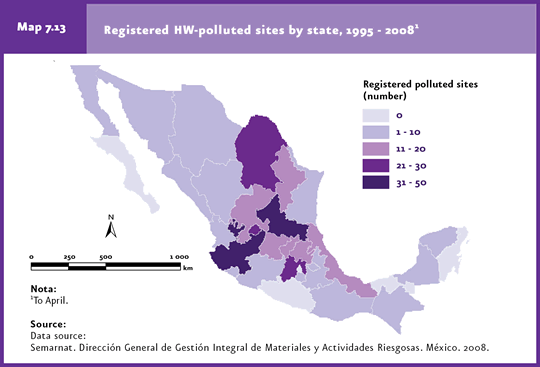
Two types of contaminated sites can be distinguished: 1) those called environmental passives and 2) those caused by environmental contingencies. |
As of 2008, a total of 333 sites contaminated with materials or HW had been recorded in Mexico. |
| CHAPTER 7. WASTES |
The inefficient or improper management of chemicals and their wastes may result in contaminated sites. These can be defined as those places where chemicals or wastes, linked to industrial, commercial, farming or household activities, have been deposited, buried or spilled. The main causes of site contamination include: a) improper disposal of USW, HW and wastes requiring special management in open dumps or industrial warehouses and yards; b) leakage of materials or HW from underground tanks or containers and pipelines, as well as from industrial or public sewage systems; c) leaching from storage sites or production facilities, or from sanitary landfills and open dumps; d) accidental spills of chemicals during transport; e) application of potentially toxic chemicals to soil, facilities and buildings; and f) discharge of untreated wastewater containing HW and potentially toxic chemicals. Two types of contaminated sites can be distinguished: 1) the so-called “environmental passives”, which are large sites, with contamination problems derived from the industrial use of land and improper HW management, and 2) those caused by environmental contingencies (EA after its initials in Spanish), and which were readily managed when these occured (Semarnat, 2008). In order to provide treatment to both the environmental passives and environmental contingencies, in 2005 there were 169 companies in the country licensed to remediate contaminated sites, with a total treatment capacity of approximately 78 million tons per year. Many of these companies focused on the remediation of hydrocarbon-contaminated sites, contrasting with the virtually nil attention given to sites polluted with metals (Semarnat, 2006). At the state level, the states with an important oil activity (such as Veracruz and Tabasco) or with a large number of industries (Federal District and the State of Mexico) had the highest installed capacity for the remediation of contaminated sites (Map 7.12).
Environmental passives In 2004, 297 sites contaminated with materials or HW had been identified. Of these, 119 had been characterized, that is, classified and prioritized according to the degree of risk these represented for human and environmental health, and other 12 sites were deemed rehabilitated or under a remediation process. As of April 2008, the number of contaminated sites recorded had increased nearly 12%, reaching 333 sites (Map 7.13, IB 5-3).
Semarnat conducts a number of actions for managing environmental passives, including the assessment of negative impacts caused by contaminated soils; review and approval of environmental risk assessment studies (ERA) and programs for the remediation of contaminated sites. Along with other entities, Semarnat has projects both for providing information on contaminated sites and on their remediation (Semarnat, 2008), including: 1) the Project denominated “Development of the Information System on Contaminated Sites SISCO” in collaboration with the German Agency for Technical Cooperation (GTZ after its initials in German); 2) the remediation project of the former “Cromatos de Mexico, S.A.” company in the State of Mexico, in collaboration with the German State of Bavaria; 3) the remediation project of the contaminated site of “Metales y Derivados”, located in Tijuana, Baja California, in cooperation with the US-EPA Border 2012 Program; 4) the remediation project of the contaminated site of “Nuevo Mercurio”, Zacatecas; 5) the remediation project of the “CYTRAR” site in Hermosillo, Sonora; 6) the remediation project of the “La Pedrera” site in Guadalcazar, San Luis Potosi; 7) the remediation project of the “Jales mineros” site in Nacozari, Sonora; and 8) the remediation project of the “Techkem” site in Salamanca, Guanajuato.
|

